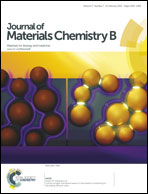Layer by layer assembly of sulfonic poly(ether sulfone) as heparin-mimicking coatings: scalable fabrication of super-hemocompatible and antibacterial membranes†
Abstract
In this study, to approach the scalable fabrication of super-hemocompatible and antibacterial membranes, surface engineered 3D heparin-mimicking coatings were designed by layer by layer (LBL) assembly of water-soluble heparin-mimicking polymer (WHP) and quaternized chitosan (QC). The low cost and scalable WHP was synthesized by a combination of polycondensation and post-carboxylation method, and the antibacterial QC was prepared by a two-step quaternization reaction. Then, the as-prepared negatively charged WHP and positively charged QC were used to conduct the LBL assembly on the widely used poly(ether sulfone) (PES) membrane surface to prepare heparin-mimicking modified membrane. The results indicated that the assembled heparin-mimicking coating nanofilms exhibited 3D porous morphology. The systematic blood compatibility and antithrombotic evaluation revealed that the functionalized membrane owned prolonged clotting times and greatly suppressed platelet adhesion and activation; further contacting activation detection (TAT and PF-4) and complement activation (C3a and C5a) experiments indicated that the heparin-mimicking membranes had lower blood activation compared to the pristine membrane. The cell observations demonstrated that the surface assembled heparin-mimicking nanofilms showed superior performances in endothelial cells adhesion and growth than the pure PES membrane. The results of the antibacterial study indicated that the QC contained coating exhibited significant inhibition ability for both Escherichia coli and Staphlococcus aureus. In general, the LBL assembled heparin-mimicking coatings conferred the functionalized PES membranes with integrated blood compatibility, cytocompatibility and antibacterial property for multi-applications, which may forward the fabrication and application of heparin-mimicking biomedical devices.


 Please wait while we load your content...
Please wait while we load your content...